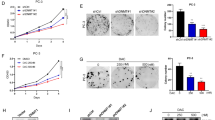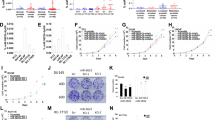Abstract
Heterochromatin protein 1γ (HP1γ) has been implicated in carcinogenesis of various cancer types. However, the role of HP1γ in prostate cancer (PCa) progression and the underlying molecular mechanisms remain largely unknown. We found that HP1γ is upregulated in PCa and elevated levels of HP1γ in PCa predict poor outcome. In addition, depletion of HP1γ in PCa cells not only repressed proliferation and induced apoptosis but also impaired tumorigenicity. We also found that c-Myc was capable of upregulating HP1γ by directly binding to the E-box element in the first intron of HP1γ gene, and the upregulated HP1γ, in turn, repressed the expression of miR-451a by enhancing H3K9 methylation at the promoter region of miR-451a. Furthermore, reduction of miR-451a significantly reversed HP1γ loss-induced PCa cell apoptosis, whereas miR-451a overexpression repressed cell survival by targeting and downregulating c-Myc. The association among c-Myc, HP1γ and miR-451a was further confirmed in human clinical samples. Therefore, we propose that an HP1γ/miR-451a/c-Myc regulatory circuitry exists in PCa cells and this circuit has a crucial role in PCa progression.
This is a preview of subscription content, access via your institution
Access options
Subscribe to this journal
Receive 50 print issues and online access
$259.00 per year
only $5.18 per issue
Buy this article
- Purchase on Springer Link
- Instant access to full article PDF
Prices may be subject to local taxes which are calculated during checkout







Similar content being viewed by others
References
Siegel RL, Miller KD, Jemal A . Cancer statistics. 2016. CA Cancer J Clin 2016; 66: 7–30.
Canzio D, Larson A, Narlikar GJ . Mechanisms of functional promiscuity by HP1 proteins. Trends Cell Biol 2014; 24: 377–386.
Bannister AJ, Zegerman P, Partridge JF, Miska EA, Thomas JO, Allshire RC et al. Selective recognition of methylated lysine 9 on histone H3 by the HP1 chromo domain. Nature 2001; 410: 120–124.
Lemaitre C, Soutoglou E . Double strand break (DSB) repair in heterochromatin and heterochromatin proteins in DSB repair. DNA Repair 2014; 19: 163–168.
Black JC, Allen A, Van Rechem C, Forbes E, Longworth M, Tschöp K et al. Conserved antagonism between JMJD2A/KDM4A and HP1γ during cell cycle progression. Mol Cell 2010; 40: 736–748.
Benetti R, Garcia-Cao M, Blasco MA . Telomere length regulates the epigenetic status of mammalian telomeres and subtelomeres. Nat Genet 2007; 39: 243–250.
Slezak J, Truong M, Huang W, Jarrard D . HP1γ expression is elevated in prostate cancer and is superior to Gleason score as a predictor of biochemical recurrence after radical prostatectomy. BMC Cancer 2013; 13: 148.
Shapiro E, Huang H, Ruoff R, Lee P, Tanese N, Logan S . The heterochromatin protein 1 family is regulated in prostate development and cancer. J Urol 2008; 179: 2435–2439.
Gabay M, Li Y, Felsher DW . MYC activation is a hallmark of cancer initiation and maintenance. Cold Spring Harb Perspect Med 2014; 4: pii: a014241.
Tomlins SA, Mehra R, Rhodes DR, Cao X, Wang L, Dhanasekaran SM et al. Integrative molecular concept modeling of prostate cancer progression. Nat Genet 2007; 39: 41–51.
Hawksworth D, Ravindranath L, Chen Y, Furusato B, Sesterhenn IA, McLeod DG et al. Overexpression of C-MYC oncogene in prostate cancer predicts biochemical recurrence. Prostate Cancer Prostatic Dis 2010; 13: 311–315.
Jenkins RB, Qian J, Lieber MM, Bostwick DG . Detection of c-myc oncogene amplification and chromosomal anomalies in metastatic prostatic carcinoma by fluorescence in situ hybridization. Cancer Res 1997; 57: 524–531.
Gurel B, Iwata T, Koh CM, Jenkins RB, Lan F, Van Dang C et al. Nuclear MYC protein overexpression is an early alteration in human prostate carcinogenesis. Mod Pathol 2008; 21: 1156–1167.
Koh CM, Bieberich CJ, Dang CV, Nelson WG, Yegnasubramanian S, De Marzo AM . MYC and prostate cancer. Genes Cancer 2010; 1: 617–628.
Shen MM, Abate-Shen C . Molecular genetics of prostate cancer: new prospects for old challenges. Genes Dev 2010; 24: 1967–2000.
Pasquinelli AE . MicroRNAs and their targets: recognition, regulation and an emerging reciprocal relationship. Nat Rev Genet 2012; 13: 271–282.
Khanmi K, Ignacimuthu S, Paulraj MG . MicroRNA in prostate cancer. Clin Chim Acta 2015; 451: 154–160.
Bertoli G, Cava C, Castiglioni I . MicroRNAs as biomarkers for diagnosis, prognosis and theranostics in prostate cancer. Int J Mol Sci 2016; 17: 421.
Riquelme I, Tapia O, Leal P, Sandoval A, Varga MG, Letelier P et al. miR-101-2, miR-125b-2 and miR-451a act as potential tumor suppressors in gastric cancer through regulation of the PI3K/AKT/mTOR pathway. Cell Oncol 2016; 39: 23–33.
Fukumoto I, Kinoshita T, Hanazawa T, Kikkawa N, Chiyomaru T, Enokida H et al. Identification of tumour suppressive microRNA-451a in hypopharyngeal squamous cell carcinoma based on microRNA expression signature. Br J Cancer 2014; 111: 386–394.
Minna E, Romeo P, Dugo M, De Cecco L, Todoerti K, Pilotti S et al. miR-451a is underexpressed and targets AKT/mTOR pathway in papillary thyroid carcinoma. Oncotarget 2016; 7: 12731–12747.
Pierorazio PM, Ross AE, Han M, Epstein JI, Partin AW, Schaeffer EM . Evolution of the clinical presentation of men undergoing radical prostatectomy for high-risk prostate cancer. BJU Int 2012; 109: 988–993.
Guan XW, Xu XH, Feng SL, Tang ZB, Chen SW, Hui L . Synthesis of hybrid 4-deoxypodophyllotoxin-5-fluorouracil compounds that inhibit cellular migration and induce cell cycle arrest. Bioorg Med Chem Lett 2016; 26: 1561–1566.
O'Donnell KA, Wentzel EA, Zeller KI, Dang CV, Mendell JT . c-Myc-regulated microRNAs modulate E2F1 expression. Nature 2005; 435: 839–843.
Luoto KR, Meng AX, Wasylishen AR, Zhao H, Coackley CL, Penn LZ et al. Tumor cell kill by c-MYC depletion: role of MYC-regulated genes that control DNA double-strand break repair. Cancer Res 2010; 70: 8748–8759.
Supino R, Favini E, Cuccuru G, Zunino F, Scovassi AI . Effect of paclitaxel on intracellular localization of c-Myc and P-c-Myc in prostate carcinoma cell lines. Ann N Y Acad Sci 2007; 1095: 175–181.
Huang MJ, Cheng YC, Liu CR, Lin S, Liu HE . A small-molecule c-Myc inhibitor, 10058-F4, induces cell-cycle arrest, apoptosis, and myeloid differentiation of human acute myeloid leukemia. Exp Hematol 2006; 34: 1480–1489.
Follis AV, Hammoudeh DI, Wang H, Prochownik EV, Metallo SJ . Structural rationale for the coupled binding and unfolding of the c-Myc oncoprotein by small molecules. Chem Biol 2008; 15: 1149–1155.
Tsai LH, Wu JY, Cheng YW, Chen CY, Sheu GT, Wu TC et al. The MZF1/c-MYC axis mediates lung adenocarcinoma progression caused by wild-type lkb1 loss. Oncogene 2015; 34: 1641–1649.
Wang H, Hammoudeh DI, Follis AV, Reese BE, Lazo JS, Metallo SJ et al. Improved low molecular weight Myc-Max inhibitors. Mol Cancer Ther 2007; 6: 2399–2408.
Borsos BN, Huliák I, Majoros H, Ujfaludi Z, Gyenis Á, Pukler P et al. Human p53 interacts with the elongating RNAPII complex and is required for the release of actinomycin D induced transcription blockage. Sci Rep 2017; 7: 40960.
Lu S, Mott JL, Harrison-Findik DD . Saturated fatty acids induce post-transcriptional regulation of HAMP mRNA via AU-rich element-binding protein, human antigen R (HuR). J Biol Chem 2015; 290: 24178–24189.
Chen D, Huang J, Zhang K, Pan B, Chen J, De W et al. MicroRNA-451 induces epithelial mesenchymal transition in docetaxel-resistant lung adenocarcinoma cells by targeting proto-oncogene c-Myc. Eur J Cancer 2014; 50: 3050–3067.
Li X, Sanda T, Look AT, Novina CD, von Boehmer H . Repression of tumor suppressor miR-451 is essential for NOTCH1-induced oncogenesis in T-ALL. J Exp Med 2011; 208: 663–675.
Pazin MJ, Caillier M, Thénot S, Tribollet V, Birot A-M, Samarut J et al. Role of the epigenetic regulator HP1γ in the control of embryonic stem cell properties. PLoS One 2010; 5: e15507.
Lee YH, Ann DK . Bi-phasic expression of heterochromatin protein 1 (HP1) during breast cancer progression: Potential roles of HP1 and chromatin structure in tumorigenesis. J Nat Sci 2015; 1: e127.
Vad-Nielsen J, Jakobsen KR, Daugaard TF, Thomsen R, Brugmann A, Sorensen BS et al. Regulatory dissection of the CBX5 and hnRNPA1 bi-directional promoter in human breast cancer cells reveals novel transcript variants differentially associated with HP1alpha down-regulation in metastatic cells. BMC Cancer 2016; 16: 32.
Shiota M, Song Y, Yokomizo A, Tada Y, Kuroiwa K, Eto M et al. Human heterochromatin protein 1 isoform HP1beta enhances androgen receptor activity and is implicated in prostate cancer growth. Endocr Relat Cancer 2010; 17: 455–467.
Itsumi M, Shiota M, Yokomizo A, Kashiwagi E, Takeuchi A, Tatsugami K et al. Human heterochromatin protein 1 isoforms regulate androgen receptor signaling in prostate cancer. J Mol Endocrinol 2013; 50: 401–409.
Yamamoto S, Midorikawa Y, Morikawa T, Nishimura Y, Sakamoto H, Ishikawa S et al. Identification of chromosomal aberrations of metastatic potential in colorectal carcinoma. Genes Chromosomes Cancer 2010; 49: 487–496.
Laitinen VH, Rantapero T, Fischer D, Vuorinen EM, Tammela TL, Wahlfors T et al. Fine-mapping the 2q37 and 17q11.2-q22 loci for novel genes and sequence variants associated with a genetic predisposition to prostate cancer. Int J Cancer 2015; 136: 2316–2327.
Babapoor S, Fleming E, Wu R, Dadras SS . A novel miR-451a isomiR, associated with amelanotypic phenotype, acts as a tumor suppressor in melanoma by retarding cell migration and invasion. PLoS One 2014; 9: e107502.
Bian HB, Pan X, Yang JS, Wang ZX, De W . Upregulation of microRNA-451 increases cisplatin sensitivity of non-small cell lung cancer cell line (A549). J Exp Clin Cancer Res 2011; 30: 20.
Liu Z, Miao T, Feng T, Jiang Z, Li M, Zhou L et al. miR-451a inhibited cell proliferation and enhanced tamoxifen sensitive in breast cancer via macrophage migration inhibitory factor. Biomed Res Int 2015; 2015: 207684.
Liu ZR, Song Y, Wan LH, Zhang YY, Zhou LM . Over-expression of miR-451a can enhance the sensitivity of breast cancer cells to tamoxifen by regulating 14-3-3zeta, estrogen receptor alpha, and autophagy. Life Sci 2016; 149: 104–113.
Ogawa H, Ishiguro K-i, Gaubatz S, Livingston DM, Nakatani Y . A complex with chromatin modifiers that occupies E2F- and Myc-responsive genes in G0 cells. Science 2002; 296: 1132–1136.
Choi JD, Park MA, Lee JS . Suppression and recovery of BRCA1-mediated transcription by HP1gamma via modulation of promoter occupancy. Nucleic Acids Res 2012; 40: 11321–11338.
Zhou J, Bi H, Zhan P, Chang C, Xu C, Huang X et al. Overexpression of HP1γ is associated with poor prognosis in non-small cell lung cancer cell through promoting cell survival. Tumour Biol 2014; 35: 9777–9785.
Takanashi M, Oikawa K, Fujita K, Kudo M, Kinoshita M, Kuroda M . Heterochromatin protein 1γ epigenetically regulates cell differentiation and exhibits potential as a therapeutic target for various types of cancers. Am J Pathol 2009; 174: 309–316.
Liu M, Huang F, Zhang D, Ju J, Wu XB, Wang Y et al. Heterochromatin protein HP1gamma promotes colorectal cancer progression and is regulated by miR-30a. Cancer Res 2015; 75: 4593–4604.
Jackstadt R, Hermeking H . MicroRNAs as regulators and mediators of c-MYC function. Biochim Biophys Acta 2015; 1849: 544–553.
Zhang X, Zhao X, Fiskus W, Lin J, Lwin T, Rao R et al. Coordinated silencing of MYC-mediated miR-29 by HDAC3 and EZH2 as a therapeutic target of histone modification in aggressive B-Cell lymphomas. Cancer Cell 2012; 22: 506–523.
Tao J, Zhao X, Tao J . c-MYC-miRNA circuitry: a central regulator of aggressive B-cell malignancies. Cell Cycle 2014; 13: 191–198.
Robinson D, Van Allen EM, Wu YM, Schultz N, Lonigro RJ et al. Integrative clinical genomics of advanced prostate cancer. Cell 2015; 161: 1215–1228.
The Cancer Genome Atlas Research Network. The molecular taxonomy of primary prostate cancer. Cell 2015; 163: 1011.
Knoepfler PS, Zhang XY, Cheng PF, Gafken PR, McMahon SB, Eisenman RN . Myc influences global chromatin structure. EMBO J 2006; 25: 2723–2734.
Maria PM, Mauro S, Laura B, Sara B, Simona N, Fiorella S et al. Myc and Omomyc functionally associate with the Protein Arginine Methyltransferase 5 (PRMT5) in glioblastoma cells. Sci Rep 2015; 5: 15494.
Rastogi S, Joshi B, Dasgupta P, Morris M, Wright K, Chellappan S . Prohibitin facilitates cellular senescence by recruiting specific corepressors to inhibit E2F target genes. Mol Cell Biol 2006; 26: 4161–4171.
Vicent GP, Nacht AS, Zaurin R, Font-Mateu J, Soronellas D, Le Dily F et al. Unliganded progesterone receptor-mediated targeting of an RNA-containing repressive complex silences a subset of hormone-inducible genes. Genes Dev 2013; 27: 1179–1197.
Rizzardi AE, Johnson AT, Vogel RI, Pambuccian SE, Henriksen J, Skubitz AP et al. Quantitative comparison of immunohistochemical staining measured by digital image analysis versus pathologist visual scoring. Diagn Pathol 2012; 7: 42.
Kang H, Hata A . Quantitative real-time PCR analysis of microRNAs and their precursors regulated by TGF-β signaling. In: Feng X-H, Xu P, Lin X (eds). TGF-β Signaling: Methods and Protocols. Springer New York: New York, NY, USA, 2016, pp 313–323.
Acknowledgements
This study was financially supported by the National Key Research and Development Plan of China (2016YFC0902202 to JY), the National Natural Science Foundation of China (81172009, 81672873 and 81372168 to JY, and 81172442 to JJ), Doctoral Fund of Ministry of Education of China (20110091120028 to JY), Natural Science Foundation for Universities in Jiangsu Province, China (BK20151396 to JY), the Center for Chronic Disorders of Aging (CCDA) at Philadelphia College of Osteopathic Medicine (to DZ), the ‘Personalized Medicines—Molecular Signature-based Drug Discovery and Development’, Strategic Priority Research Program of the Chinese Academy of Sciences, Grant No. XDA12020108 (to RH), One Hundred Talent Program of Chinese Academy of Sciences (to RH), Program sponsored for Scientific Innovation Research of College Graduate in Jiangsu province (KYZZ_0037 to CC), the Open Foundation of State Key Laboratory of Pharmaceutical Biotechnology, Nanjing University (KF-GN-201602) and the State Key Laboratory of Drug Research, Shanghai Institute of Materia Medica, Chinese Academy of Sciences (SIMM1705KF-02). We also thank Jun Qin and Min Jiang for their help in data retrieval from TCGA database.
Author contributions
RH, DZ and JY designed the study. CC and WH performed the experiments. CC, XH and MQ performed IHC on human prostate cancer slides; JJ performed IHC on human prostate cancer tissue array; CC, JL and LS performed PCR array; and CC, YD and JJ analyzed the data and performed the statistics. CC, YD, X-YF, HG, RH, DZ and JY analyzed and interpreted the data. CC, RH, DZ and JY wrote the manuscript. JY supervised the study.
Author information
Authors and Affiliations
Corresponding author
Ethics declarations
Competing interests
The authors declare no conflict of interest.
Additional information
Supplementary Information accompanies this paper on the Oncogene website
Supplementary information
Rights and permissions
About this article
Cite this article
Chang, C., Liu, J., He, W. et al. A regulatory circuit HP1γ/miR-451a/c-Myc promotes prostate cancer progression. Oncogene 37, 415–426 (2018). https://doi.org/10.1038/onc.2017.332
Received:
Revised:
Accepted:
Published:
Issue Date:
DOI: https://doi.org/10.1038/onc.2017.332
This article is cited by
-
Co-amplification of CBX3 with EGFR or RAC1 in human cancers corroborated by a conserved genetic interaction among the genes
Cell Death Discovery (2023)
-
Smoking-associated upregulation of CBX3 suppresses ARHGAP24 expression to activate Rac1 signaling and promote tumor progression in lung adenocarcinoma
Oncogene (2022)
-
Circulating RNA biomarkers in diffuse large B-cell lymphoma: a systematic review
Experimental Hematology & Oncology (2021)
-
CBX7 suppresses urinary bladder cancer progression via modulating AKR1B10–ERK signaling
Cell Death & Disease (2021)
-
microRNA-451a promoter methylation regulated by DNMT3B expedites bladder cancer development via the EPHA2/PI3K/AKT axis
BMC Cancer (2020)



